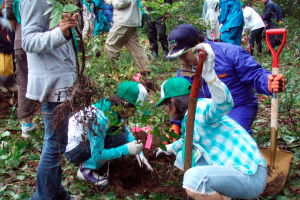
Top page > Water resources > Column: "The forest is the ocean's sweetheart"
In Japan it has been believed from the days of our ancestors that "the forest calls the fish" and many forests on the coastline were protected as "fish-breeding" forests. Studies seeking scientific grounds for such traditional practices have proved that the degradation of forest environments in river basins have prevented forest minerals from the forest from flowing out to the rivers and to the ocean, therefore inhibiting phytoplankton growth, thereby inflicting declining catches[1].
An effort to address this issue has been established in Miomotegawa River in Niigata Prefecture. Miomotegawa River is sourced in the Asahi mountain range which stretches across Niigata and Yamagata Prefectures. The river flows from virgin beech forests in Asahi district in Murakami City, out to the metropolitan area of the city.
The Miomotegawa River is famous for salmon which was a valuable source of revenue for the Murakami clan, which governed the region in the Edo era (1603-1868). However, salmon was overexploited to the extent that the depletion of salmon resources was feared and the clan decided to implement efforts to protect salmon as fisheries resource. For example, knowing that the salmon was a migratory fish, Buheiji Aoto, a Murakami clan member, devised a way to keep salmon enclosed in a part of the river's sandbar, which was appropriate for spawning, thereby protecting the eggs until they could hatch in the spring.
Also, guided by the idea that in order to conserve the abundant oceans and rivers that foster fisheries resources, rich forests were essential, the Murakami clan had preserved the forests near the outlet of the Miomotegawa River as "salmon-calling forests.[2]" However, recent development has caused the forest environment along the river to diminish and the river water to become contaminated. Against this background, forestry and fisheries industries and nature conservation organizations joined hands to revive traditional practices and pass on the water source forests of the Miomotegawa River to future generations as "Salmon Forests." They established the Council for the Promotion of Salmon Forest Planting in 1999 and started tree-planting activities the following year.
The Council for the Promotion of Salmon Forest Planting comprises local governments, situated along the Miomotegawa River, relevant national and prefectural government organizations, Niigata Prefectural Fisheries Cooperation, forestry cooperatives that are directly related to forest management, local forest-supporting youth groups, and environmental groups. The Council plants 100 to 200 young beech trees and cuts underbrush every year in the national forests in the headwaters of Sarutagawa River, a tributary of the Miomotegawa River. Murakami City grants 200 thousand yen annually (sourced 20 percent from the general budget and 80 percent from subsidies from Niigata Prefecture) in support of these activities. The number of participants in annual activities have increased from 70 to 80 people in 1999 to over 130 in 2008, and has continued an upwards trend since.
The Council is also focused on environmental education for local children for the purposes of spreading understanding for its activities and fostering a concerned future generation that will engage in ongoing efforts. These undertakings have been appreciated at a nationwide level and the Council was awarded the Chairman's prize in the fisheries conservation category of the 27th National Healthy Ocean-Making Contest. The Council for the Promotion of Salmon Forest Planting has become a pioneering example that inspired the development of seven other groups in Niigata Prefecture.

Photo: Planting young beech trees
in the water source of Miomotegawa River ©Murakami City
The Murakami clan's example is actually only one of many local forest-planting efforts that date back to older times. However, such activities attracted much attention when fisheries resources declined drastically in the late 1980s and afforestation campaigns were launched in Hokkaido, Tohoku region and the Noto Peninsula engaging fishermen near the estuaries to plant trees in the river basin or along the coastline. For example, in Kesennuma City in Miyagi Prefecture, when the oyster catch was dominated by "bleeding" oysters that had absorbed red tide plankton, an oyster farmer, Shigeatsu Hatakeyama led other fishermen to plant forests under the slogan "Mori wa Umi no Koibito" (The Forest is the Ocean's Sweetheart) in 1989. In Hokkaido, as well, the "Osakana fuyasu shokuju undo" (Plant trees for More Fish Campaign) was launched in 1988 to engage people across the island in afforestation activities under the slogan, "100 years to restore the natural sea coast of 100 years ago."
Later in 2001, the Basic Fisheries Act stipulated that "the State shall take measures such as conservation of water quality, protection and development of breeding grounds of aquatic plants and animals, conservation and developments of forests and others necessary to improve and conserve the growing environment for aquatic plants and animals" (Article 17). The Fisheries Agency then implemented a five-year plan named the "Fishermen's Forest-Planting Activities Promotion Program" to promote afforestation activities by fishermen under which it supports the undertakings of local afforestation councils, environmental surveys, promotion activities, and volunteer afforestation and silivicultural activities including the distribution of seedlings. This quickly motivated fishermen all over Japan to go up into the forests to plant trees.
Now that the government-led program has ended, forest-making activities by fishermen have been taken over by local governments, some of which fund such programs with tax revenue from forest environment taxes (see "Forest" section) and NGOs, and continue to evolve in the local context. As of March 2010, 177 programs are implemented in 33 prefectures (Marine Blue 21, 2010).
[1] BP net,1 August 2008, ECO JAPAN Inteview: Professor Katsuhiko Matsunaga, Yotsukaichi University (Part 1) Studies on iron to solve biodiversity issues: ferrous ions and leaf mold reveal links between organisms and nature
http://eco.nikkeibp.co.jp/style/eco/interview/080801_matsunaga01
[2] Total area of 2.42 hectares, this forest was designated a "fish-breeding" forest in 1911 and henceforth.
•References
·-Marine Blue 21 (2010) Survey on Status of "Fishermen's Forest-Planting Activities in 2009"
http://www.marineblue.or.jp/jigyou/mori_21.pdf
•Special thanks to
Murakami City
Marine Blue 21


